Disclosure: This post contains affiliate links that I may earn a small commission from if you purchase something through them. This comes at no extra cost to you!
An essential destination on any Cambodia itinerary, the ancient city of Angkor near Siem Reap is the number one tourist destination in the country and a symbol of national pride.
As well as being the largest religious site in the world and former Khmer capital, the expansive 400km² complex is also a UNESCO World Heritage site that is packed with around 900 beautiful temples.
The most famous of the temples is undoubtedly Angkor Wat (meaning ‘temple city’), but there are many highlights of a trip to the Angkor Archeological Zone that rival its greatness.
Watch a magical sunrise you’ll never forget, wander amongst the giant banyan trees and jungle roots that slowly reclaim the “Tomb Raider temple” of Ta Prohm, see how many faces you can find etched in stone at Bayon (clue… there’s over 200!) and admire the area from various towers and viewpoints. The list goes on!
Visiting Angkor is simply an unmissable attraction in Cambodia and with this guide I’ll take you to the best places in the expansive zone in just one day, including useful tips, fun facts and all relevant information.
Table of Contents...
Toggle
Useful information for Siem Reap
- Country: Cambodia
- Language: Khmer
- Population: 250,000
- Currency: Cambodia uses two currencies, USD and Cambodian Riel. You can pay in either, although USD is more common. If you buy something in USD that costs less than $1, you’ll get your change back in Riel. £1/$1 = 5100/4100 Riel.
- Visa info: Most nationalities can get a visa on arrival at a Cambodian air or land border. The price varies but is around $30-$40 (must be paid in USD), and it is valid for one month.
- SIM cards: I highly getting a SIM card for your travels in Cambodia. This means you can use apps like Grab for cheaper taxi fares but it also means you’re always connected to the world, never needing to rely on WiFi. Metfone, Smart & Cellcard are the three options and all have good coverage. You can also get an E-SIM on Get Your Guide which is valid in more than one country. Choose your plan here.
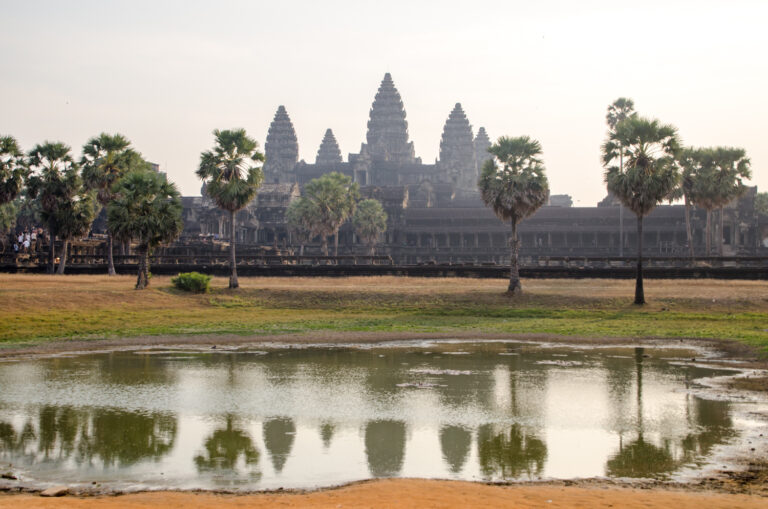
A brief history of Angkor Wat
At nearly 1,000 years old, the ancient city of Angkor was built by the kings of the Khmer Empire in the 12th century and was their capital until the 15th century. At the time it was the largest and most advanced city on Earth.
Angkor Wat itself was built between 1115 – 1150, taking roughly 30 years to complete. It was originally dedicated to the Hindu god Vishnu before changing to a Buddhist temple by the end of the 12th century.
More recently, some temples have visible bullet holes from the Cambodian Civil War in the 1970s, but overall the temples were mostly, miraculously, undamaged.
In 1992 Angkor gained UNESCO World Heritage status and is now considered one of the most important archaeological sites on the planet, welcoming around 2 million visitors per year.
Where is Angkor Wat
Angkor Wat is located in the northwest of Cambodia just 6km from Siem Reap, the country’s second largest city.
Check out the location on the interactive map below
Getting around
You have three main options to get around the city of Angkor. I strongly recommend you don’t even think about walking… it’s much bigger than you may think!
- Rent a tuktuk and driver: By far the best option for practicality and efficiency is to rent a tuktuk driver for the day. They know the best route to take and will get you around in a timely fashion. It’s also very affordable at around $25 USD for the day which is really not that bad, especially if there’s more than one or you. Hostels and hotels will happily help you sort this out. Personally, I chose this option, for which I paid $18 for the tuktuk plus a bit extra to have a guide come along for the day as well.
- Book a tour: The most comfortable yet most expensive option is to book a small group tour. Companies like GetYourGuide and Viator offer great tours of Angkor Wat in the comfort of a minivan and with a knowledgeable local guide with your every step of the way. This tour is one of the most popular.
- Cycle: Bicycles can be found in Siem Reap for around $4 per day and are a great way to explore the complex under your own steam. Be prepared for long, sweaty day under the sun if you go for this option though, as you’ll need to peddle 6km just to get to the entrance!
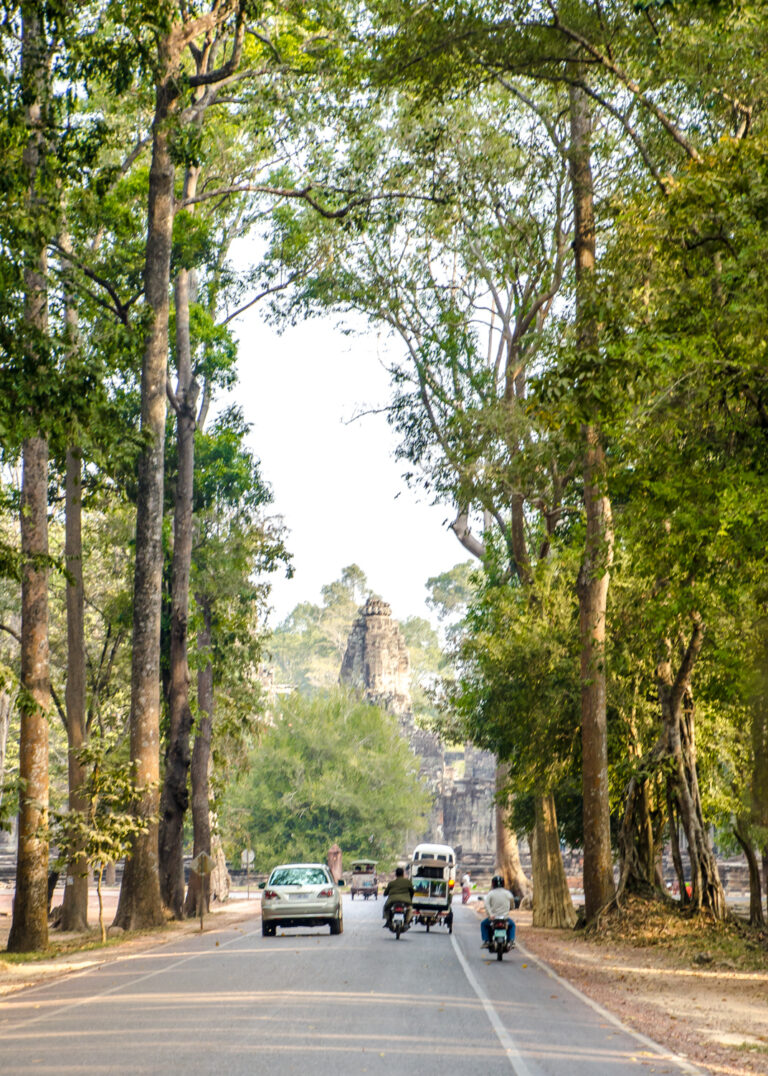
Expected costs
Unless you are Cambodian, you need a ticket to enter the Angkor Archeological Zone.
A 1-day pass is $37, a 3-day pass is $62 and a 7-day pass is $72.
In this itinerary, we’re just going to be taking the one day pass to see the highlights, but if you have all the time in the world you totally should buy a 3 day pass and do Angkor Wat in its entirety!
A tuktuk and driver should cost between $20 – $25 for the day depending on your negotiation skills, and a guided group tour usually costs around $40.
Breakfast, lunch and water shouldn’t cost you more than $6 in Angkor.
How much time to allow
Like I said earlier, you could spend days exploring the temples here.
It depends on how you get around and how many temples you want to visit, but what I will say is that you need to spend at least one full day here. If you just thought you’d spend an hour or two… you may as well not bother at all. There’s too much to see!
I think you’ll be surprised how much you can do in one day at Angkor Wat, especially if you start at 4am for sunrise! If you’re feeling super dedicated you could even stay from sunrise to sunset to milk it for all it’s worth.
Angkor Wat 1 day itinerary
The best sites to visit in Angkor Wat in 1 day:
- Angkor Wat
- Angkor Thom
- Bayon
- Baphuon
- Terrace of The Elephants
- Terrace of The Lepers
- Ta Prohm
- Banteay Kdai
- Srah Srang
Assuming you hired a tuktuk or vehicle for the day, your driver will collect you from your accommodation at around 4:30am (obviously this depends on the current daylight hours) and head to the ticketing office at Angkor.
After collecting your tickets, cross the floating pontoon and head into the city of Angkor in the pitch dark with the hundreds of other visitors. Yes, that’s right – you’re never alone here, not even at 5am!
Sunrise lake
The best (and most popular) spot for sunrise is at a small lake to the west if the main temple. Your driver may direct you there or alternatively, for once, just follow the crowd!
Sunrise at Angkor Wat is commonly referred to as one of the most beautiful sunrises in the world, and the secret sure got out! By the time I arrived at 5:30am it was already mobbed.
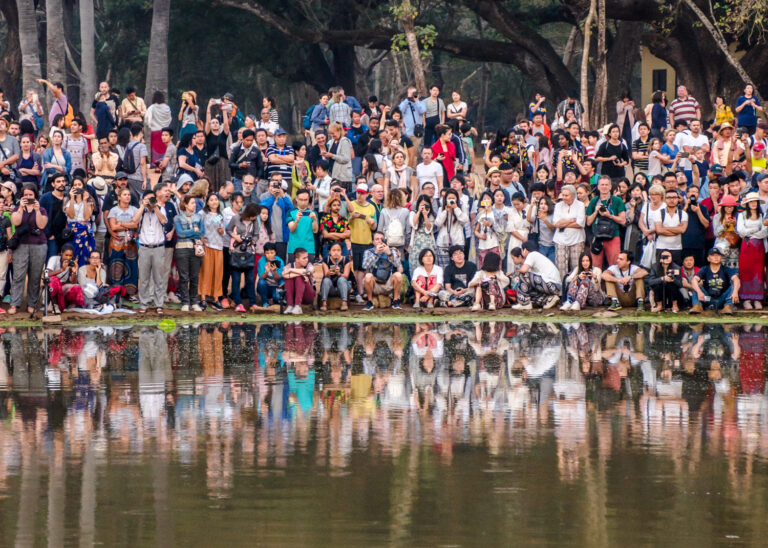
Try to find a space and make sure you have your camera ready because before you know it, the faint outline of Angkor Wat becomes visible and the vibrant sky blasts beautiful orange, purple and pink tones.
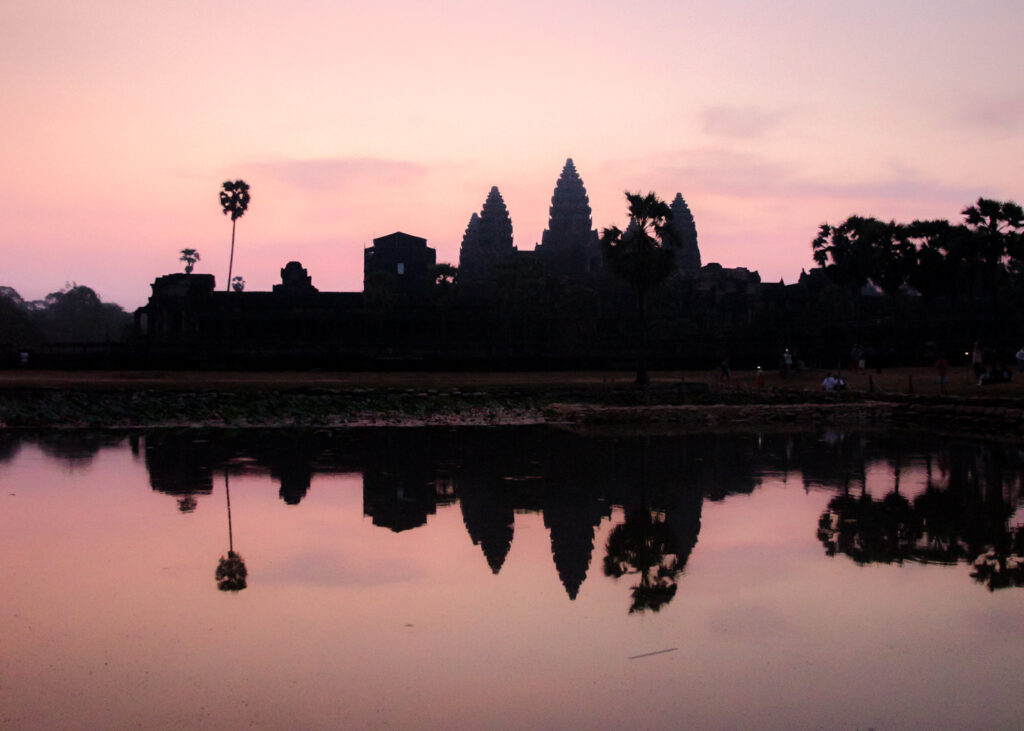
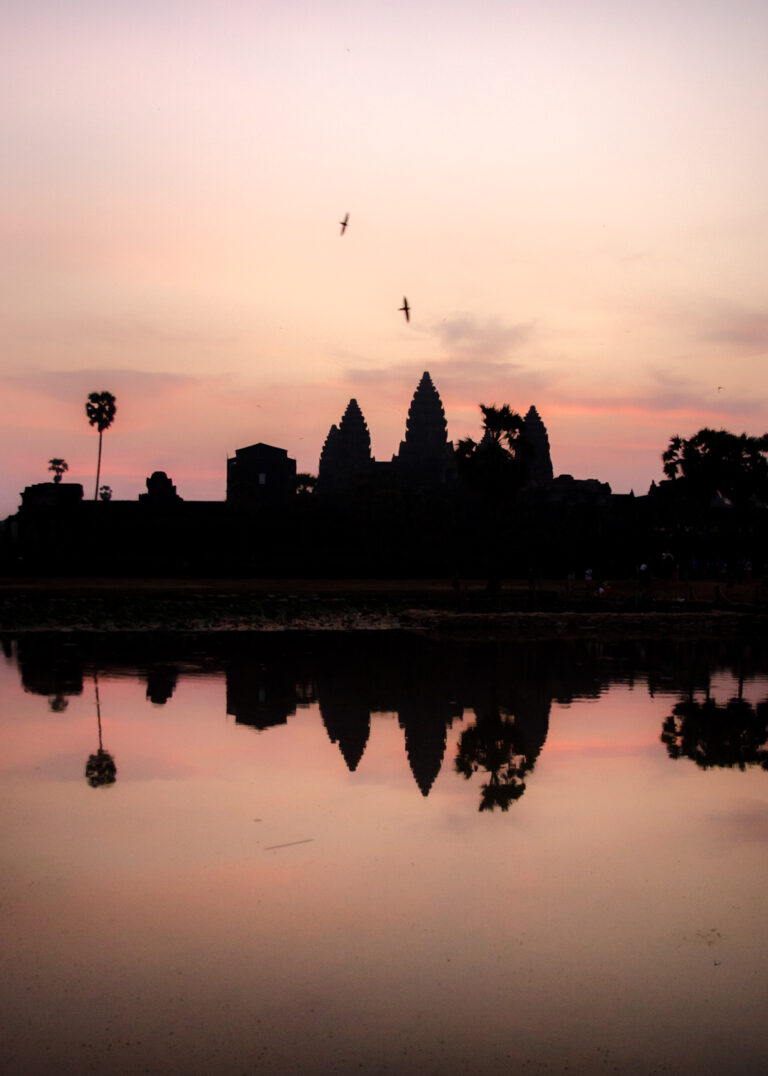
Watch the sun slowly creep over the temple’s silhouette and, once you’re satisfied, its time to get exploring before everyone else does!
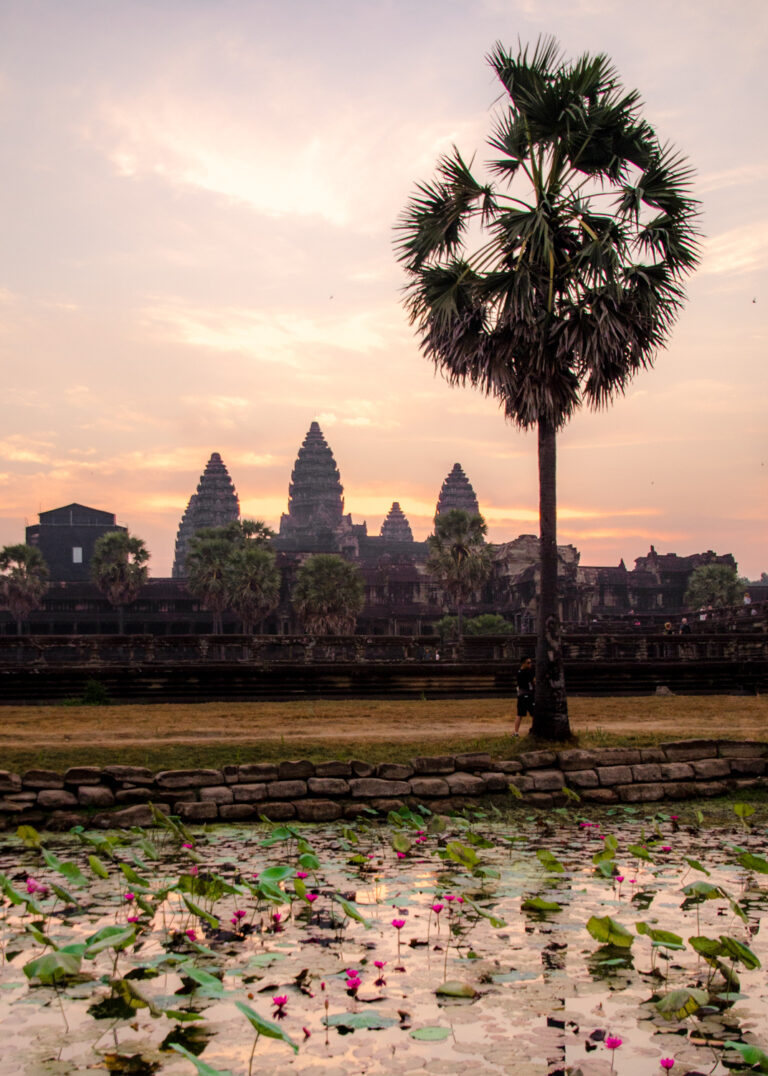
Angkor Wat
Standing at over 61 meters at its highest point and even featuring on the Cambodian national flag, after sunrise it’s time to explore Angkor Wat – the one that takes all the headlines.
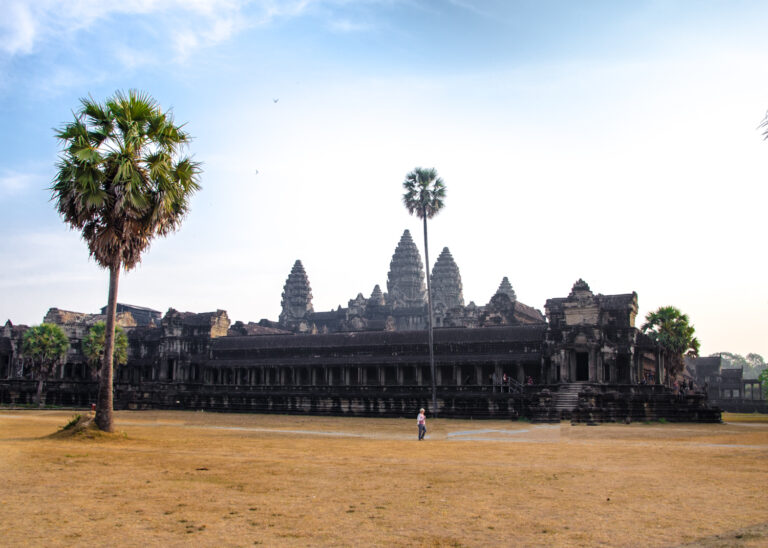
Surrounded by a moat and outer wall measuring 3.2km, the temple was dedicated to Hindu God Vishnu and was built for King Suryavarman II in the early 12th century.
Climb the steep stairs to the highest tower for a beautiful morning view over the whole area, with every angle providing a completely different scene.
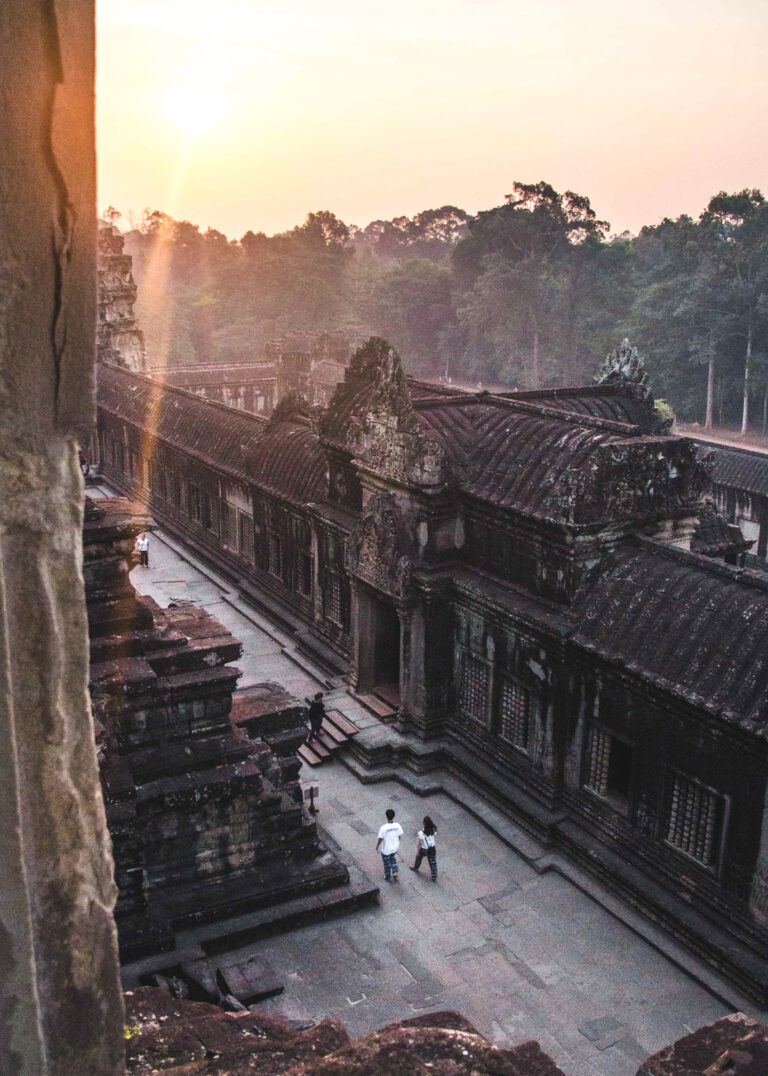
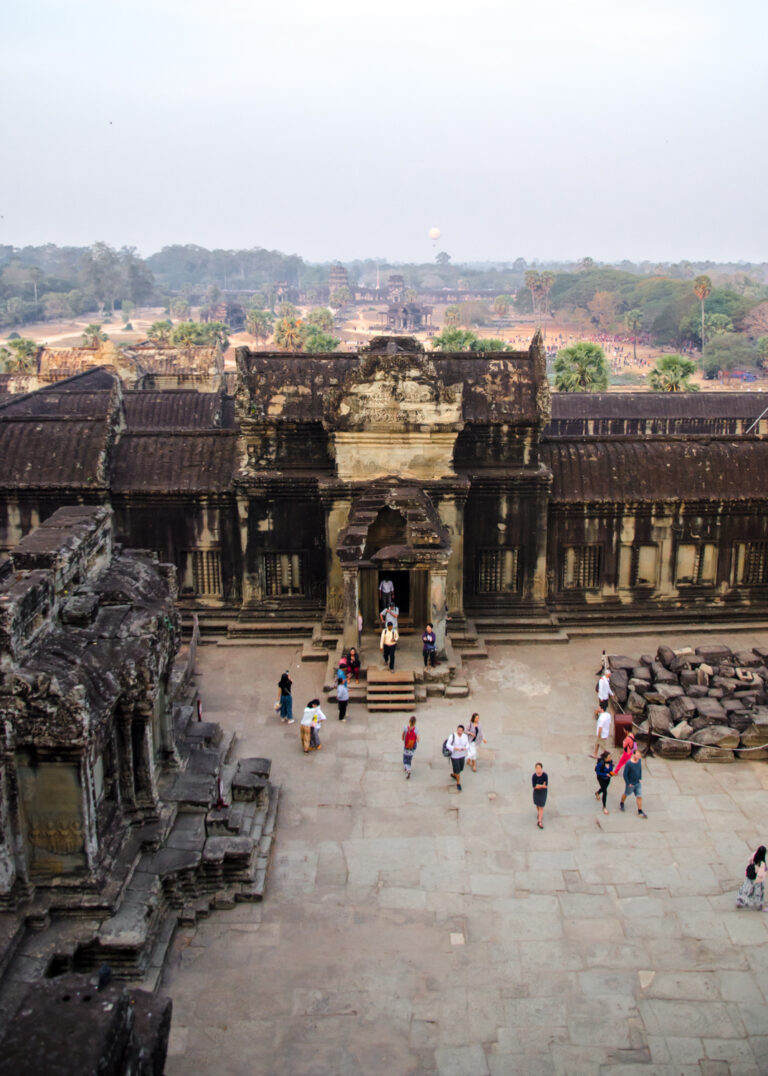
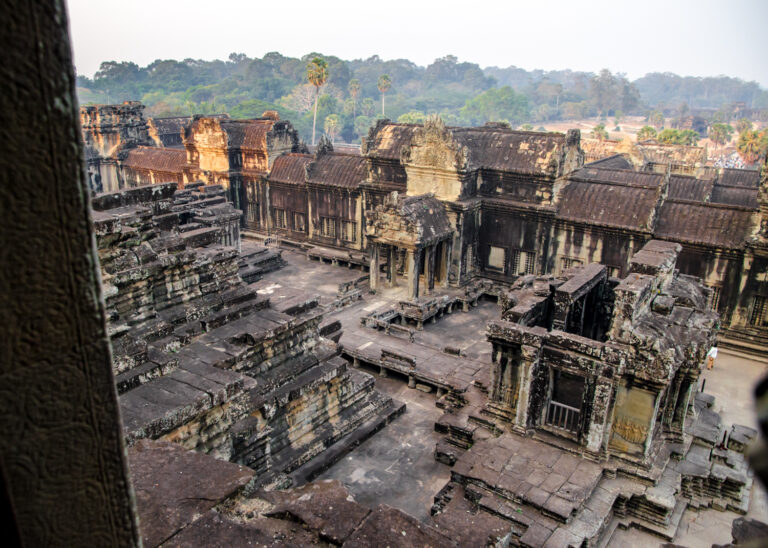
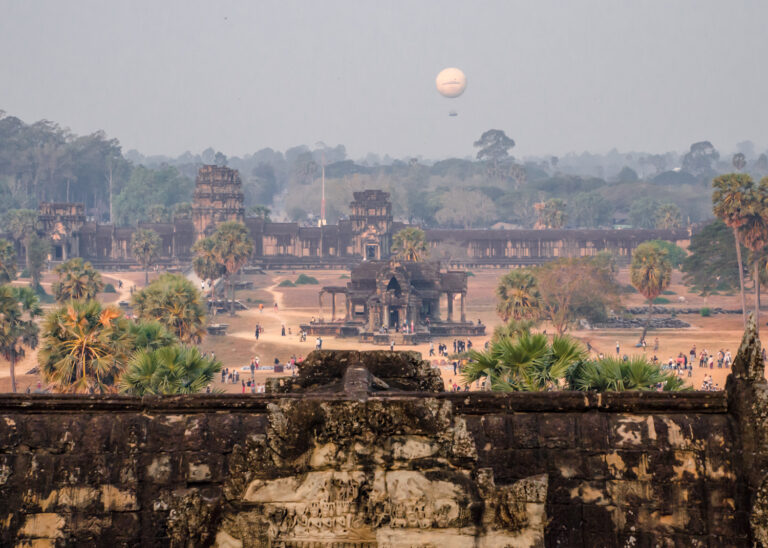
There were only about 20 people in the queue for the tower when I visited, so this was another benefit of turning up at the opening time. By the time I left it was four times as long!
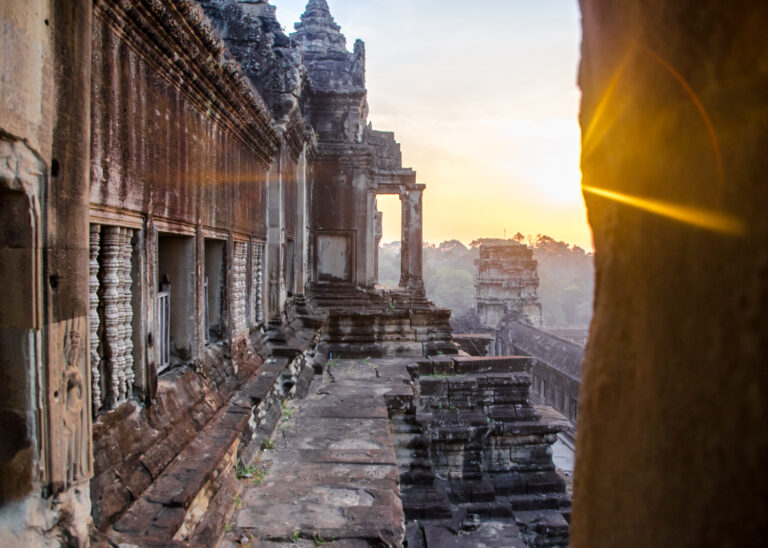
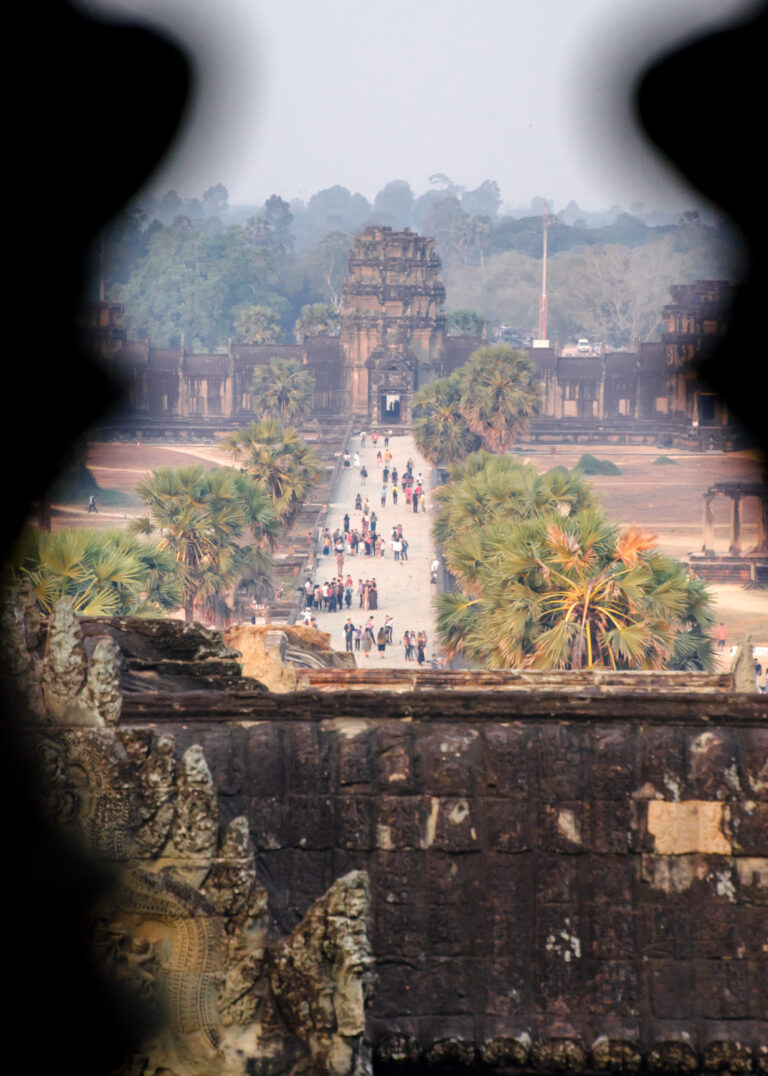
In the Hall of a Thousand Gods you’ll find four epic bathing pools which are around half the size of an Olympic swimming pool each!
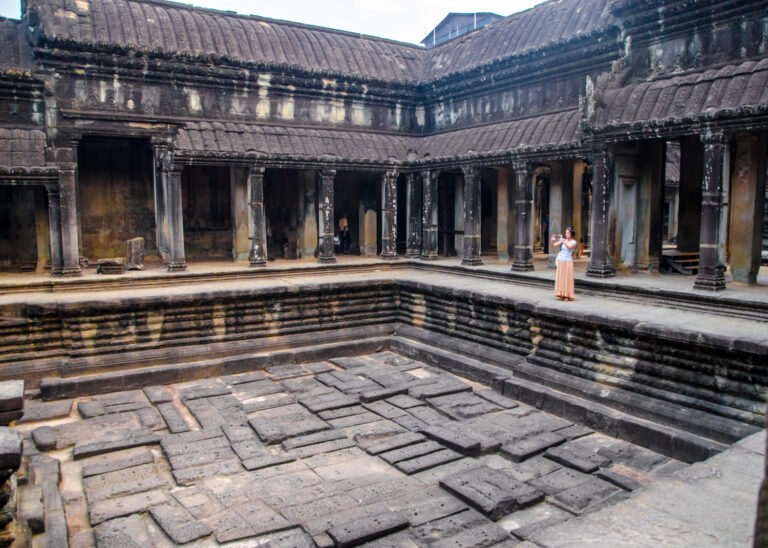
Walking around you can see intricate carvings and engravings on the concrete walls, each one telling a different story. The best place at Angkor Wat to see a story told through carvings is ‘Churning of the Sea of Milk Gallery’ at its southeast corner.
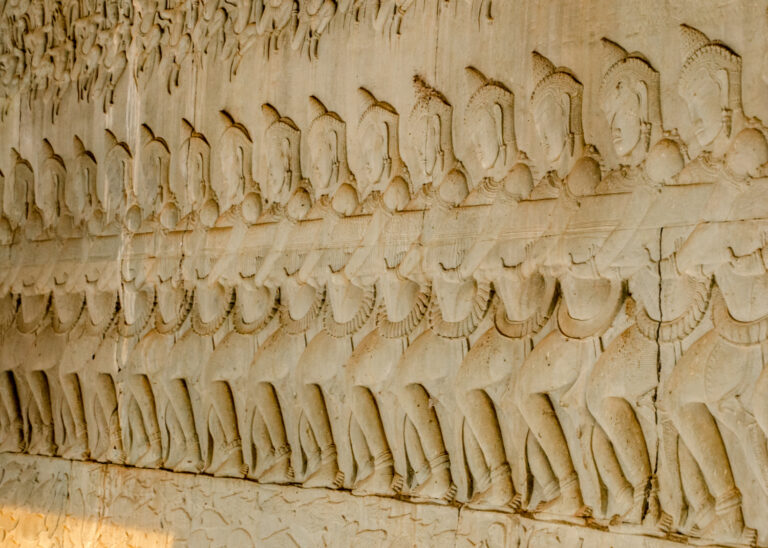
Inside the perimeter walls of Angkor Wat there are also two stunning library buildings called the Thousand God Libraries.
Climb the broken stairs and have a look inside!
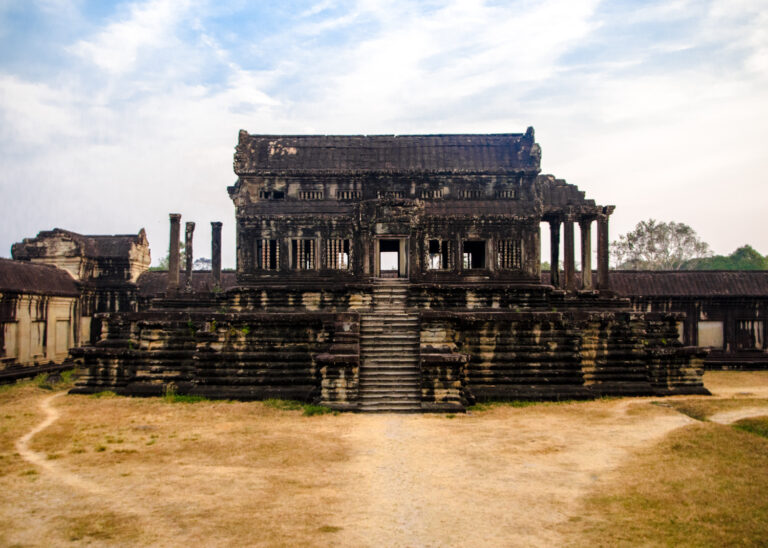
In total, I recommend spending around an hour exploring Angkor Wat before moving to Angkor Thom. You’ll want to get there before the biggest crowds and tour groups beat you to it!
Angkor Thom
Nearby to Angkor Wat is Angkor Thom, a massive fortified city brimming with its own temples. This was the last capital city of the Khmer Empire and covers a whopping 9km².
The scenes that await you in Angkor Thom are just jaw-dropping, with iconic structures like Bayon, Baphoun, The Terrace of the Elephants and The Terrace of the Leper King stealing the show.
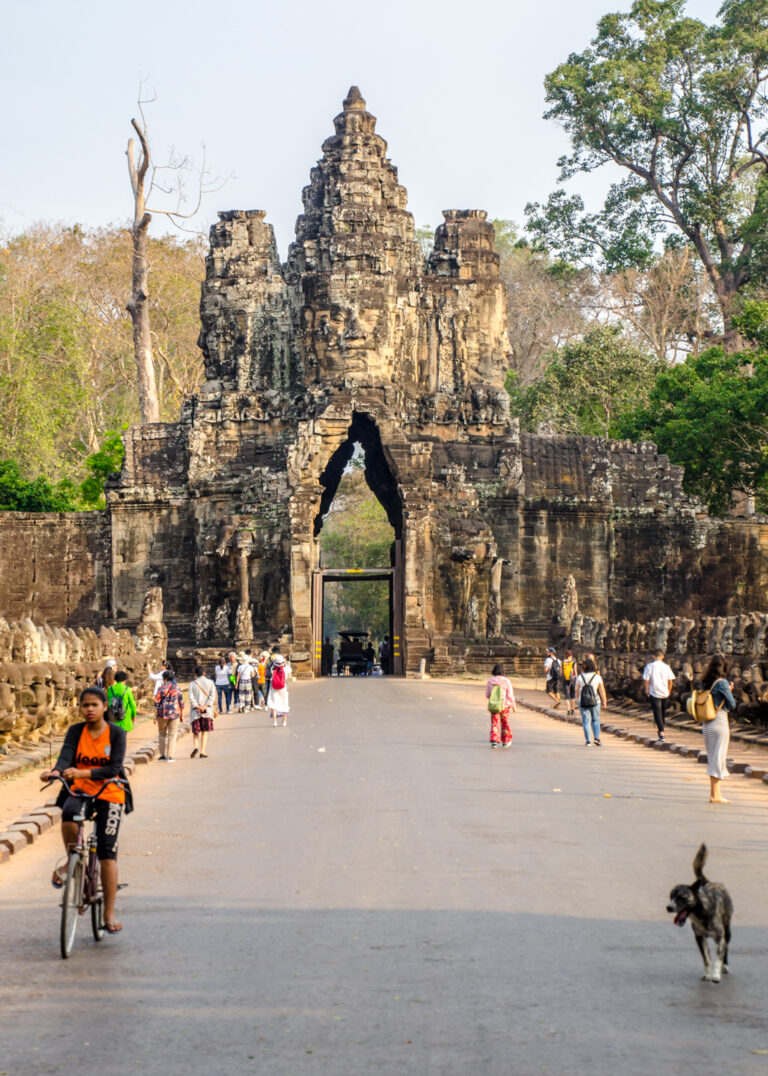
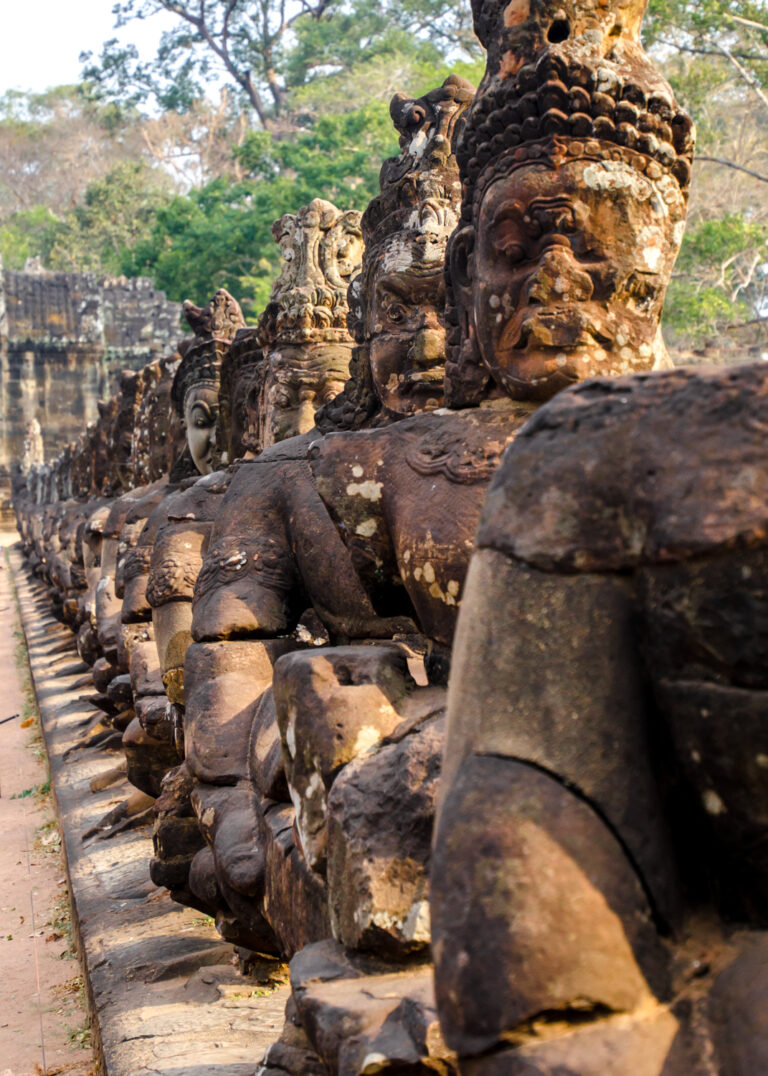
Bayon Temple
Bayon Temple is situated slap-bang in the centre of Angkor Thom and is the main temple in the city.
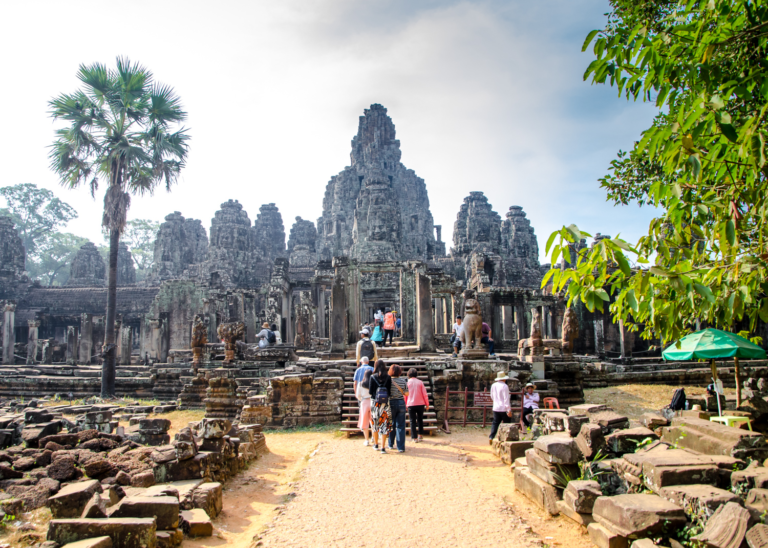
With 54 large towers and 216 smiling Buddhas carved into stone throughout the complex, it is understandably known as the ‘Temple of Many Faces’, though it was previously known as both “Jayagiri” (meaning “Victory Mountain”) and “Banyan” (the type of tree in the area).
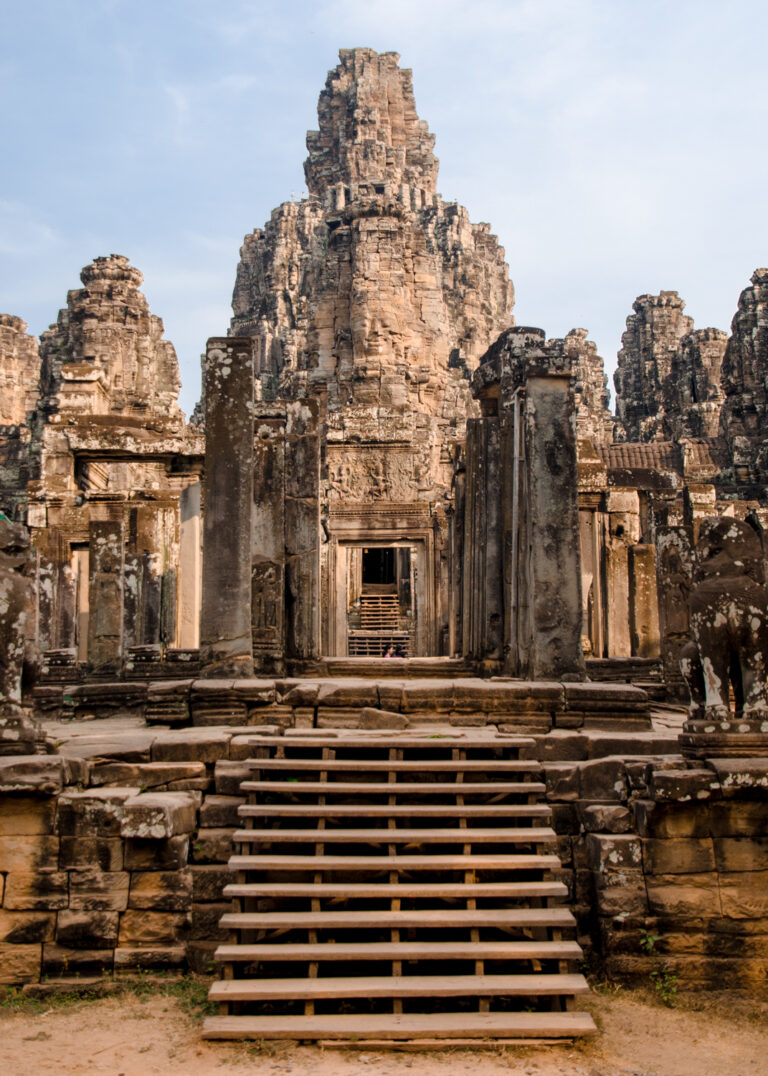
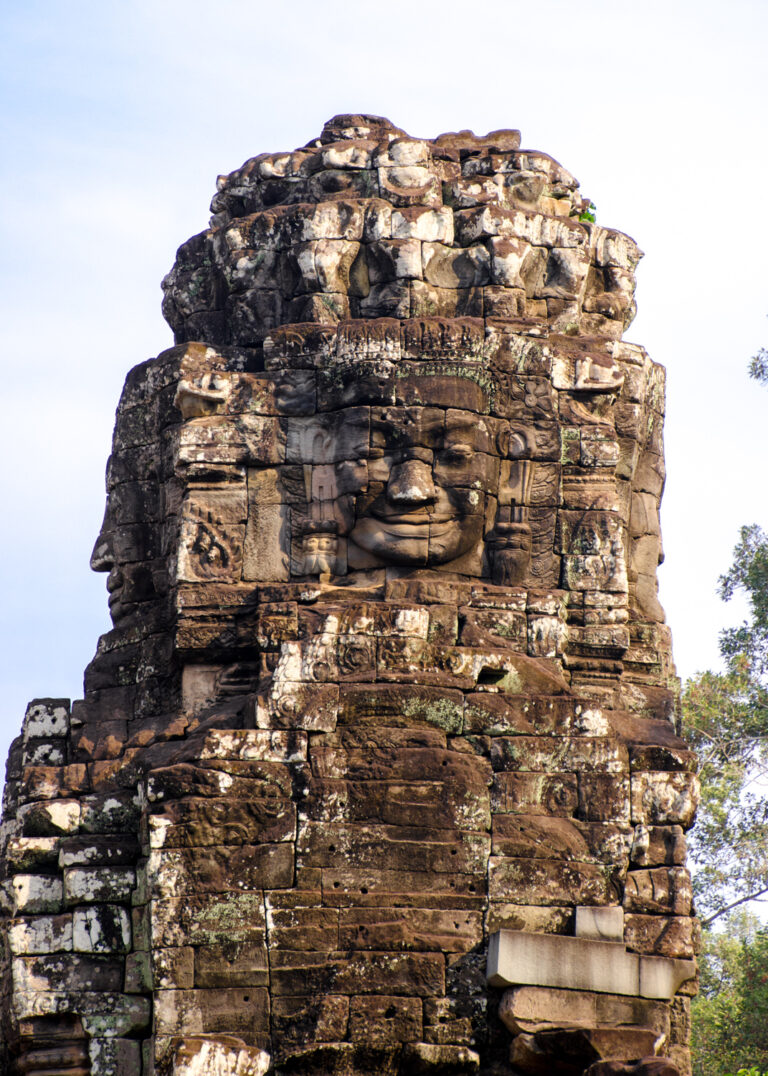
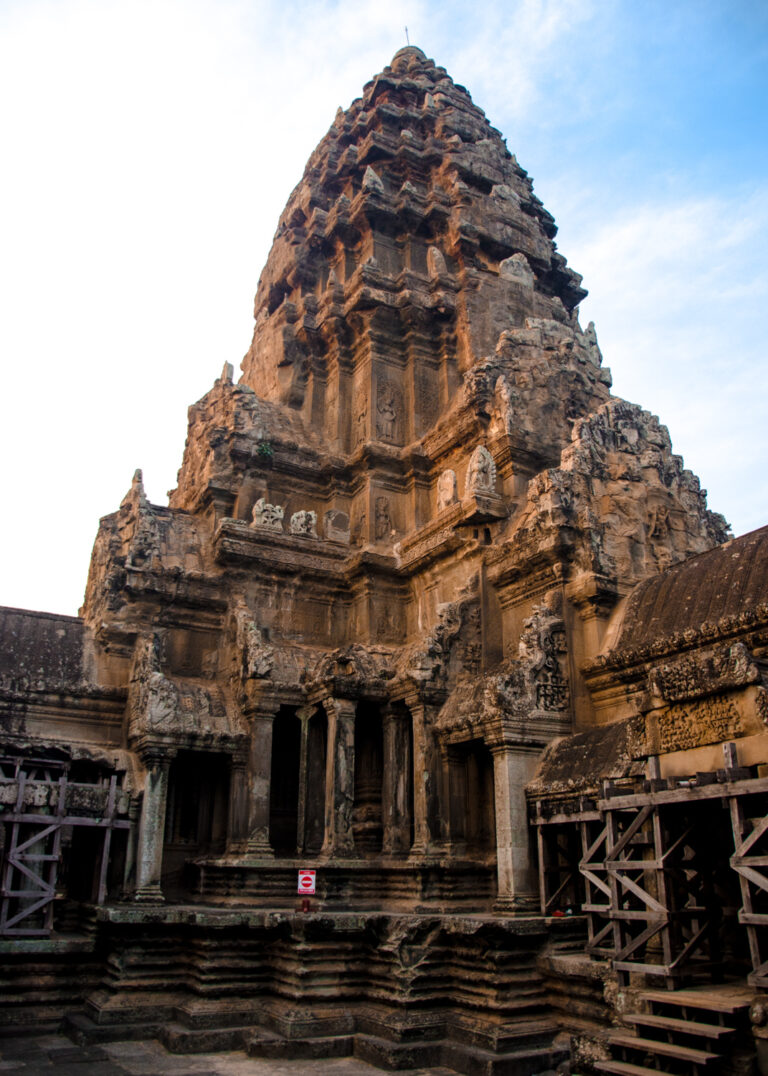
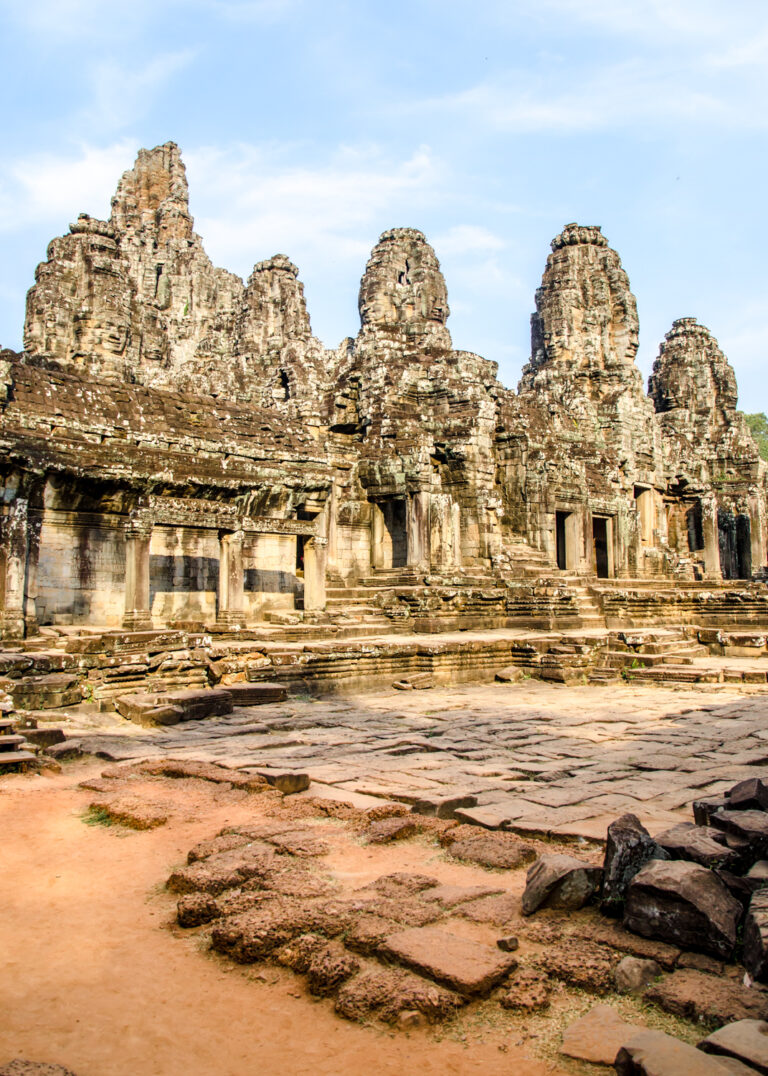
Surrounded by thick jungle, Bayon is pretty small and compact compared to other temples in Angkor, but there are so many cool spots and hidden passages to check out that you could get lost for hours here.
Although much of the temple remains in ruin, they do a pretty good job of keeping it well-maintained but with a rustic feel.

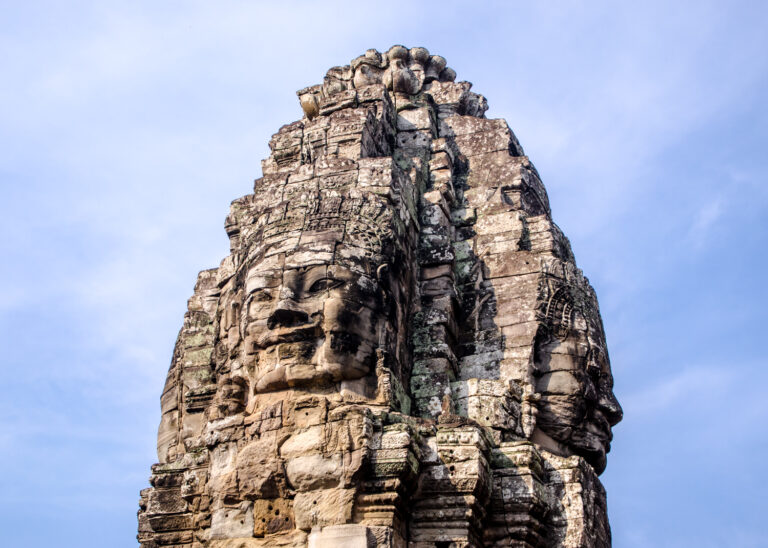
Definitely allow atleast an hour or two to wander through the maze of passages and stairways and see how many faces you can spot!
Baphuon Temple
Nearby Bayon is the 11th century Hindu temple of Baphuon.
Dedicated to Shiva, Baphuon is a three-tiered temple that features a picturesque 220 metre long elevated path up to the entrance.
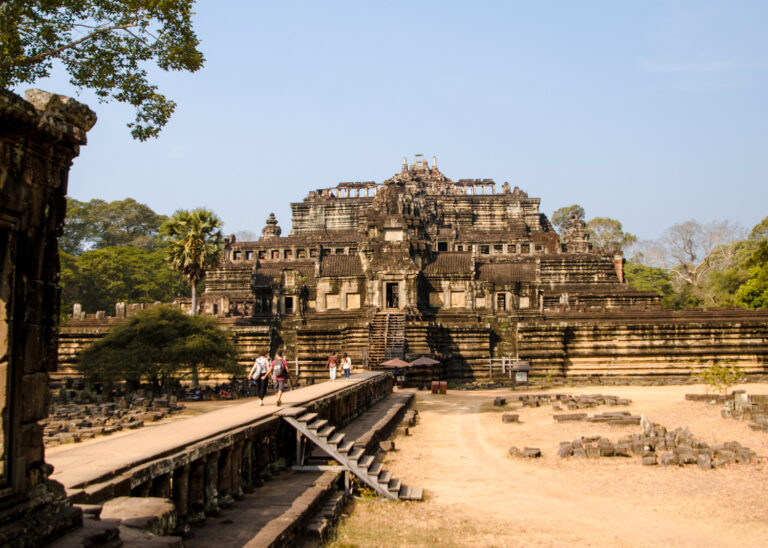
It is similar in size to Bayon and shares many characteristics with its neighbour. Unfortunately, it has not been looked after as well and has been fairly destroyed over time. I guess it’s understandable after around 900 years of abuse from Mother Nature!
It’s also far quieter than is neighbour which is great for exploring, and the view from the top tier is fantastic!
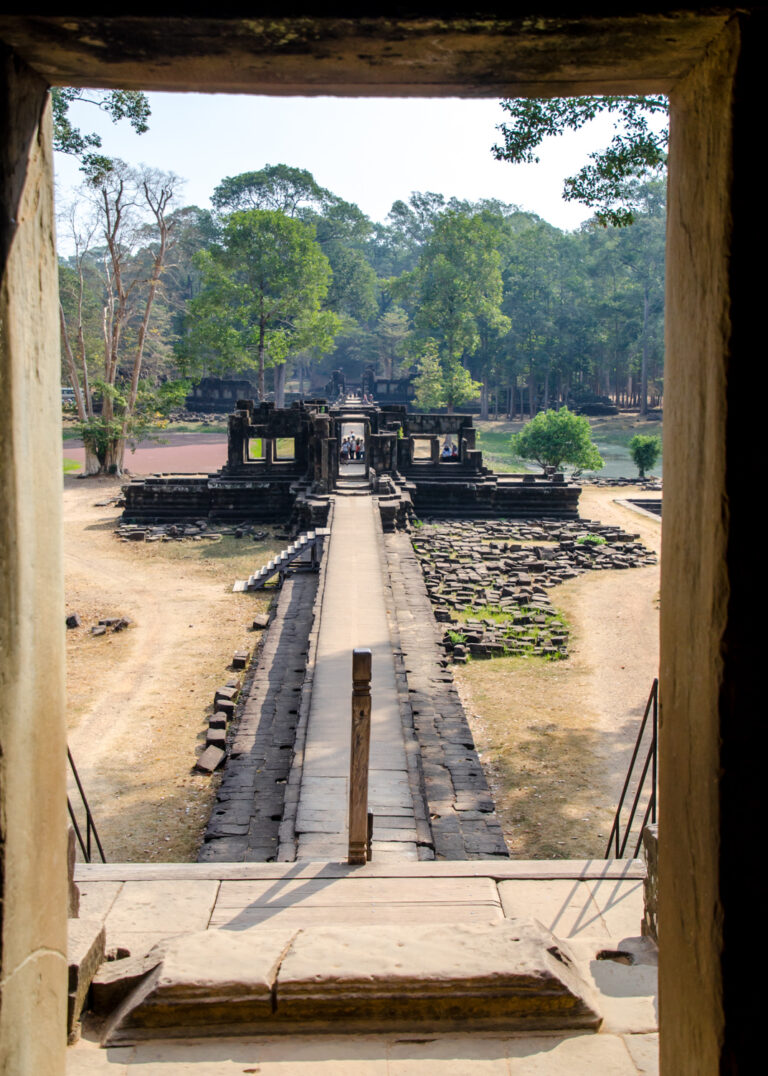
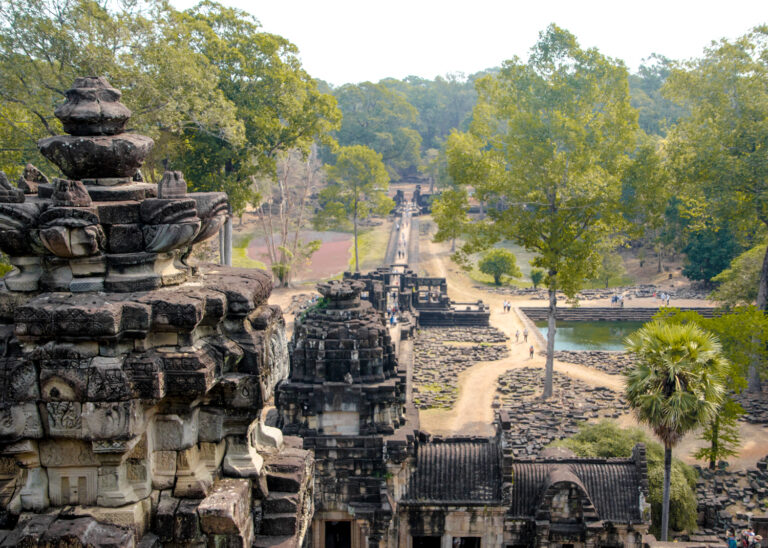
Terrace of the Elephants
Stretching around 350 meters, the Terrace of the Elephants is a raised platform decorated with elephant carvings and statues.
It was used in ceremonies and parades by the Khmer kings.
Terrace of the Leper King
In the northwest corner of Angkor Thom lies the Terrace of the Leper King.
The Leper King is a statue depicting a naked, sexless person. There’s a lot of confusion over who it is, but it’s believed that the this was formally a crematorium and the statue is of Yama, the god of death.
The original statue is on display at the National Museum in Phnom Penh and the one you see at Angkor Wat is actually just a copy.
Ta Prohm
Next up is my favourite temple in Angkor Wat and a complete vibe-switch.
Suddenly, you’ll forget you’re just 6km away from the second largest city in Cambodia because when you step foot in this mysterious jungle setting it’s like something straight out of a fantasy book!
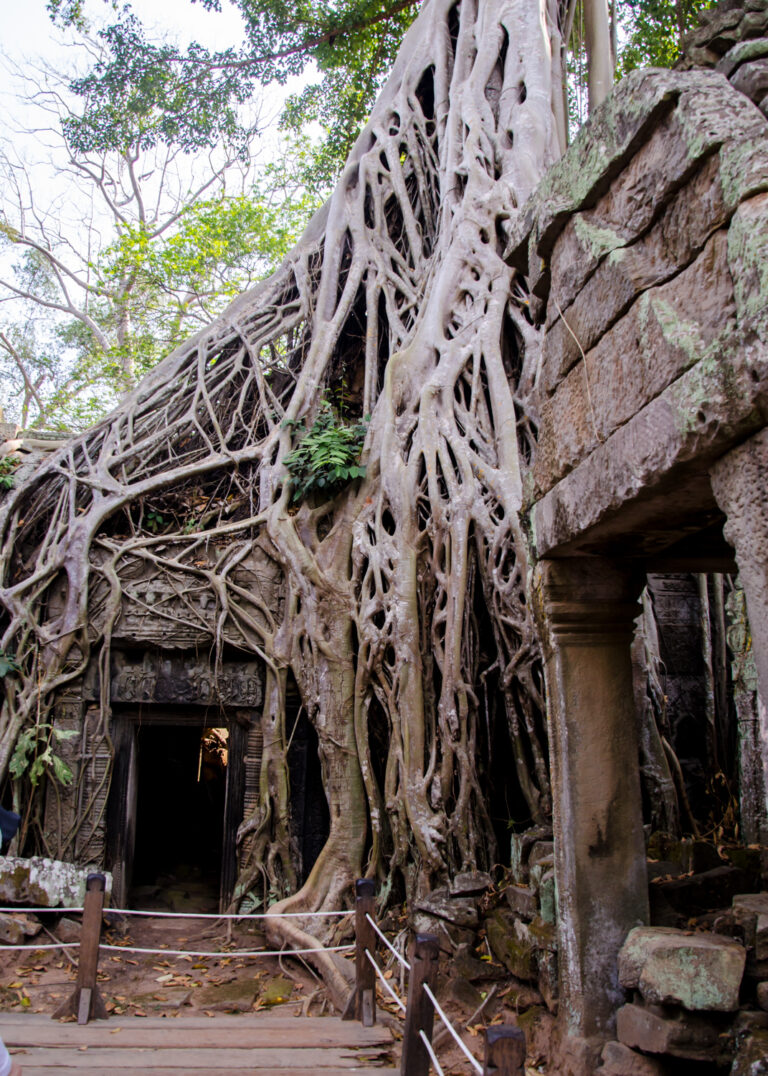
Ta Prohm is fully engulfed by a dense forest. It has so much character and is far more impressive than you can imagine simply from looking at photos or watching movies… ‘Lara Croft: Tomb Raider’ anyone?!
Towering banyan trees and entangled roots and vines have reclaimed the temple ruins and balance precariously on top of the walls in some places. Some of the trees are 400-500 years old and are the height of 2 or 3 standard houses… and they’re living and balancing on an ancient temple wall! It’s just awesome.
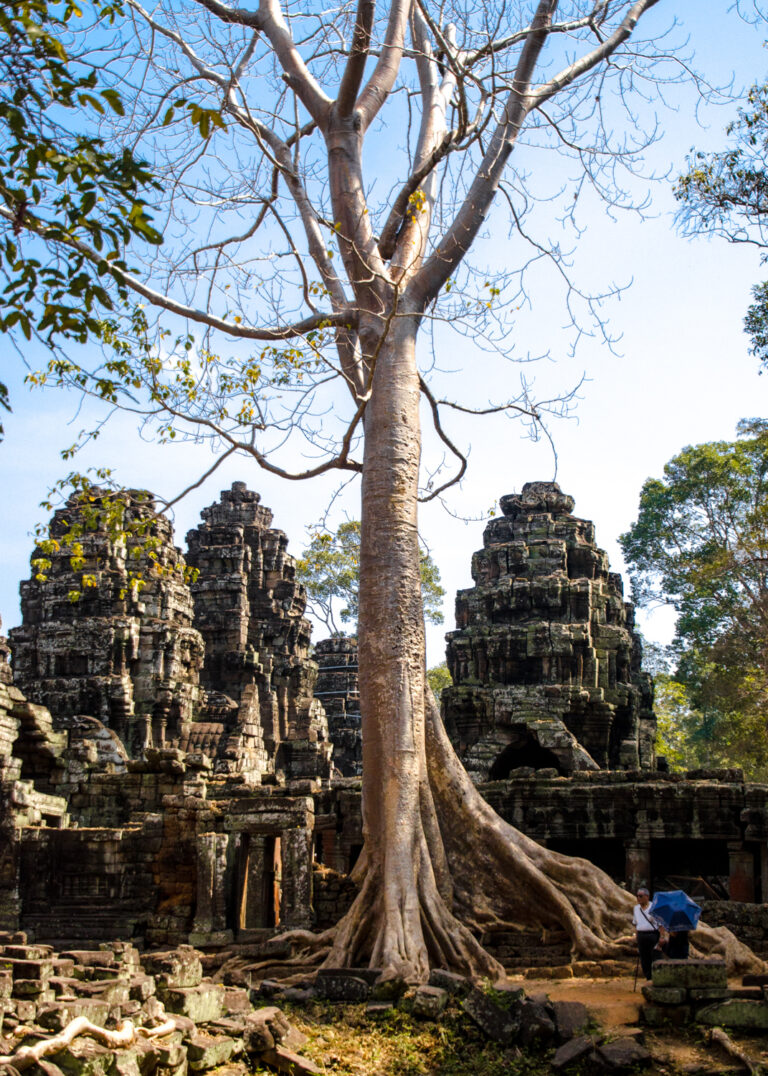
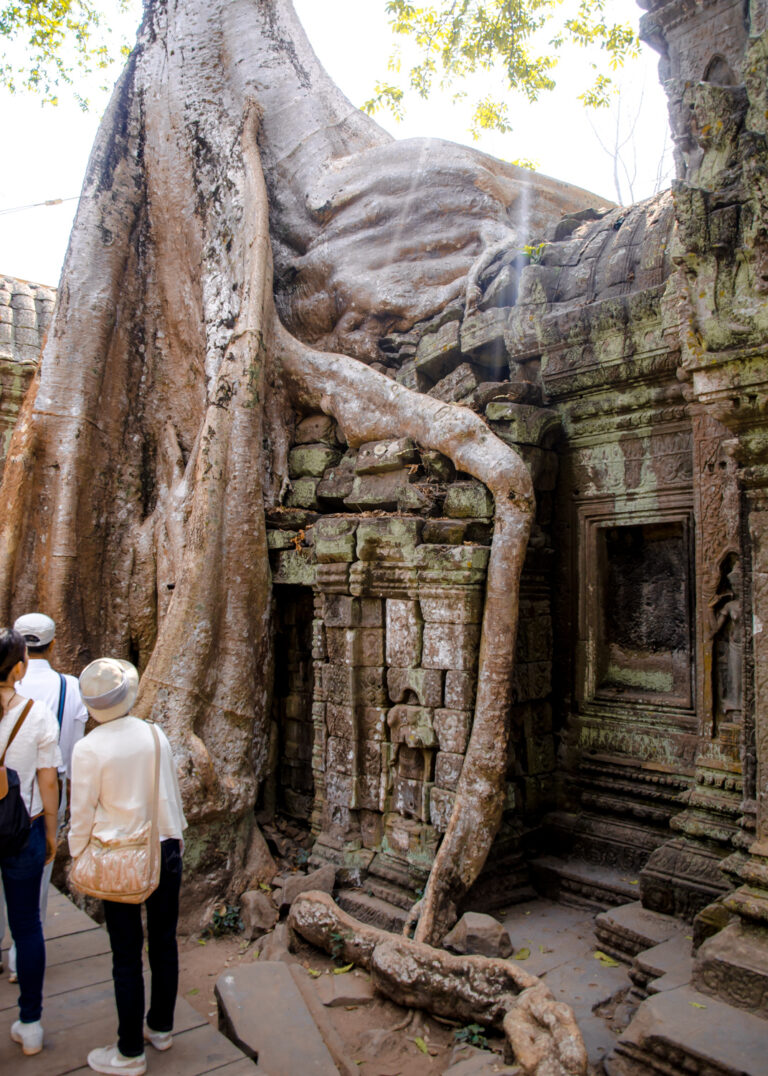
The enormous trees support the temple walls, while the temple walls support the trees. It’s a surreal sight to behold and seemingly unbelievable that both are still standing.
There is constant construction going on at Ta Prohm as walls continuously crack and break under the strain, but the completely ruined state of it just adds even more to the cool jungle vibe.
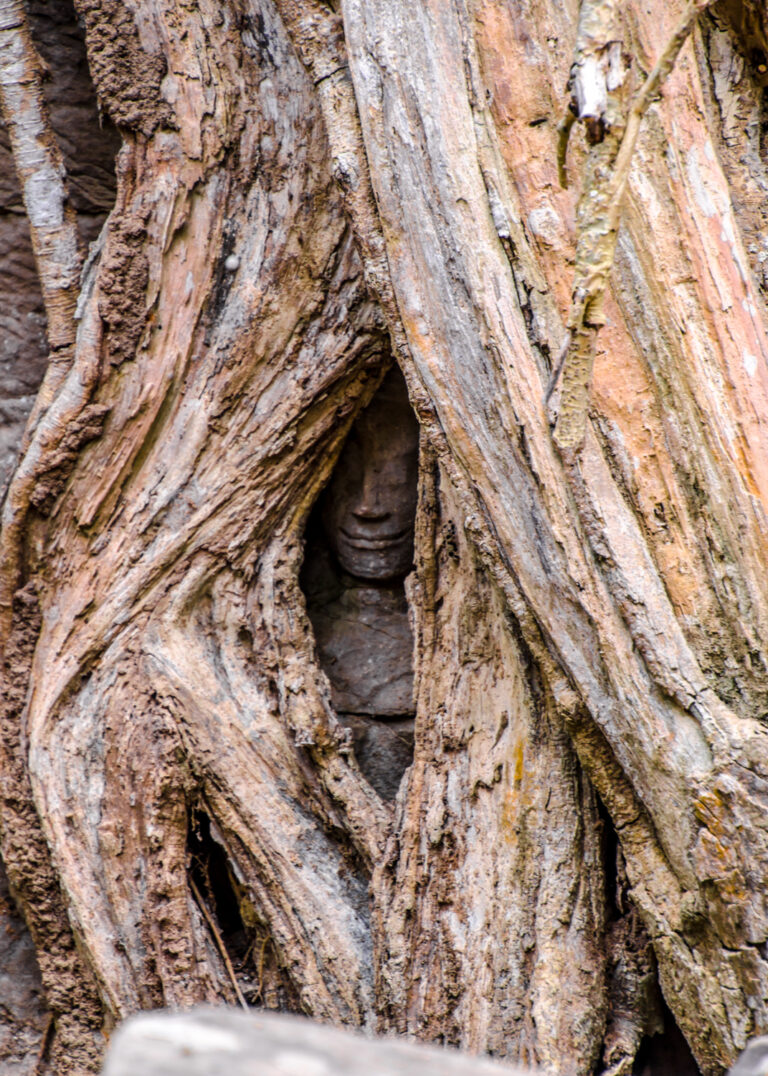
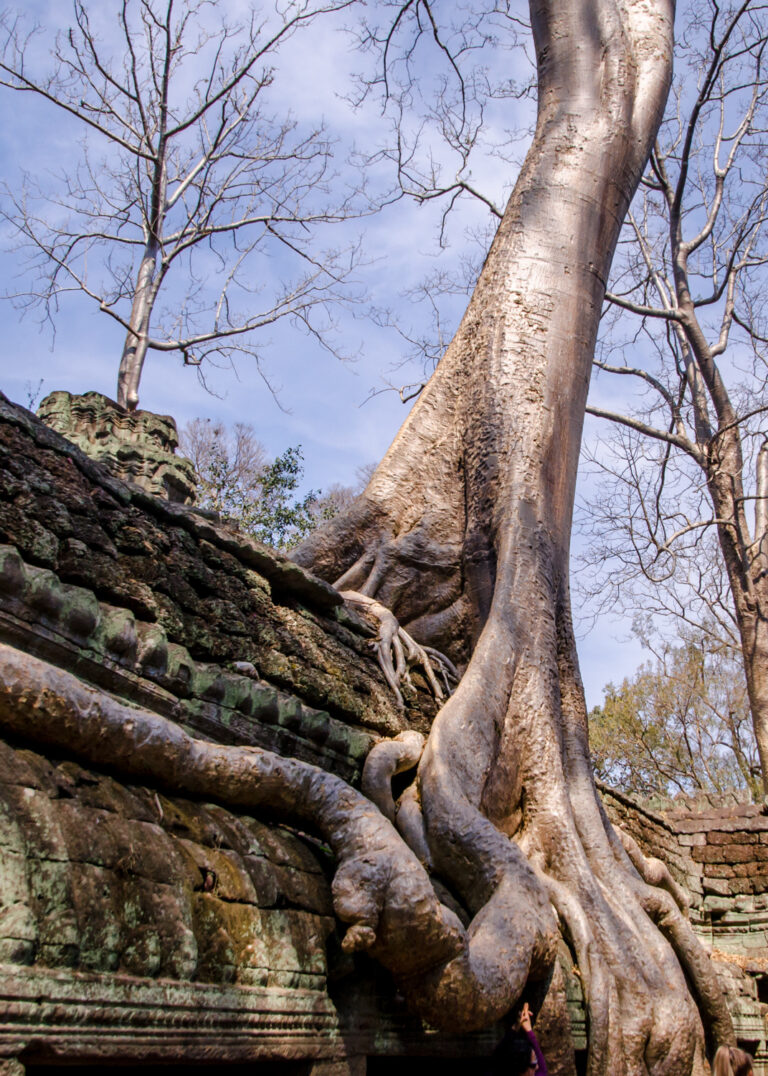
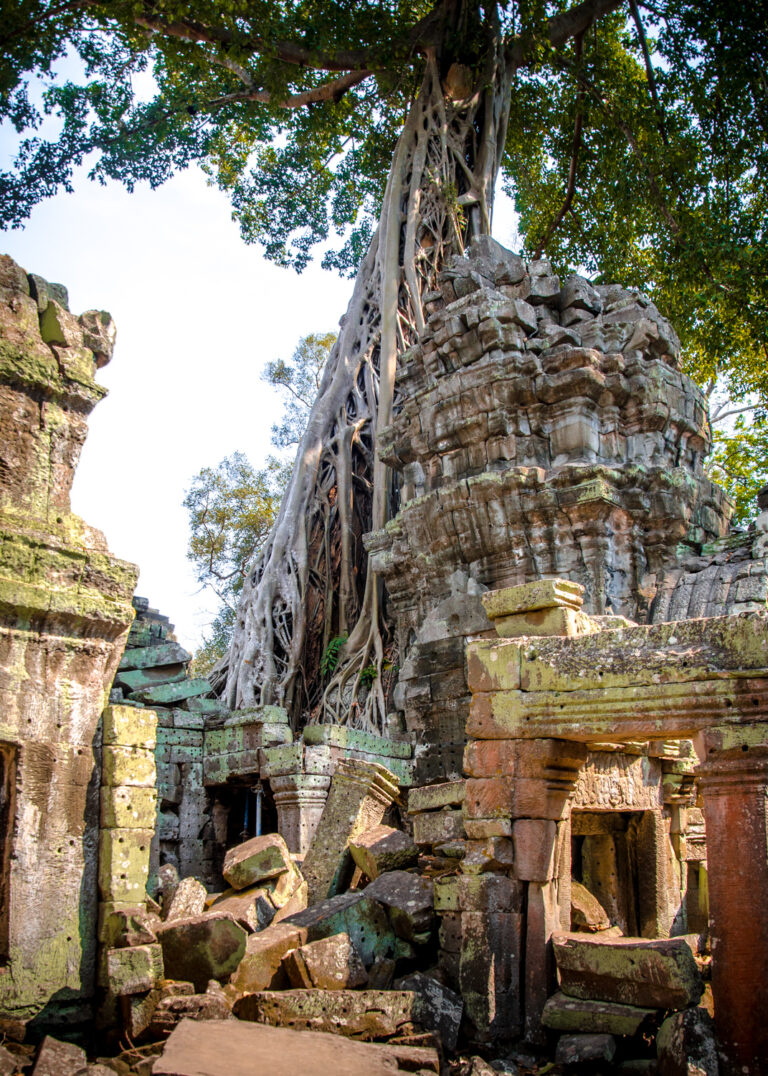
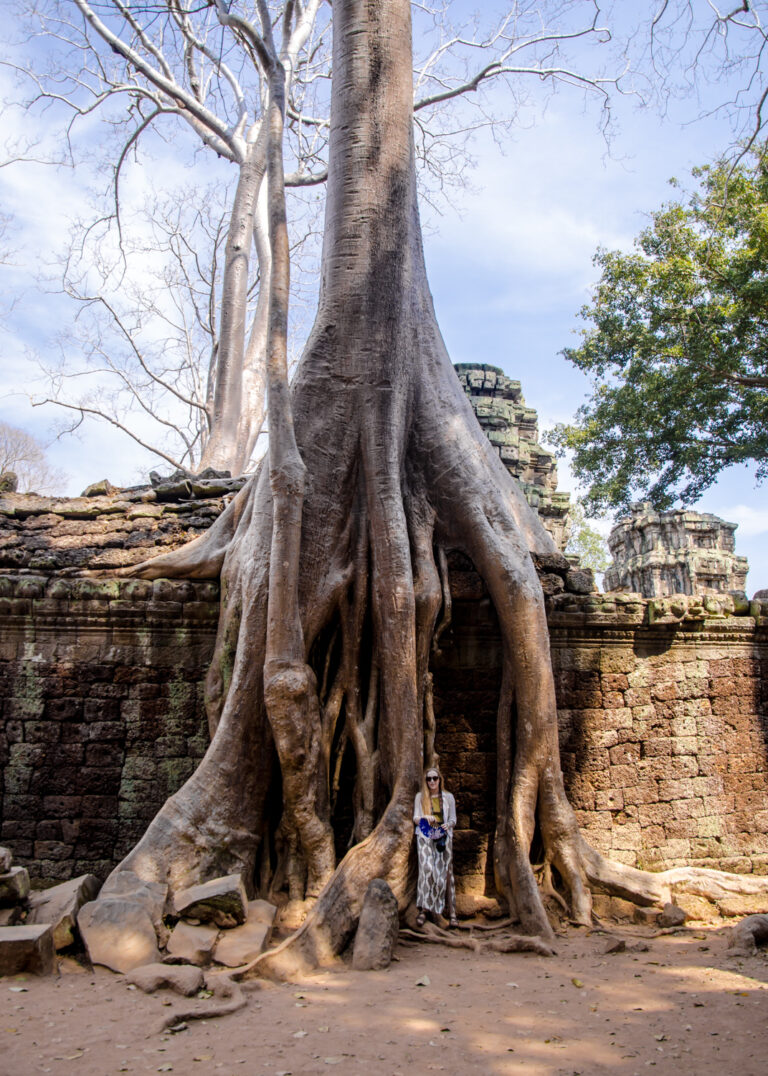
Explore the majestic courtyards, alleyways and rooms of Ta Prohm before heading on to Banteay Kdai.
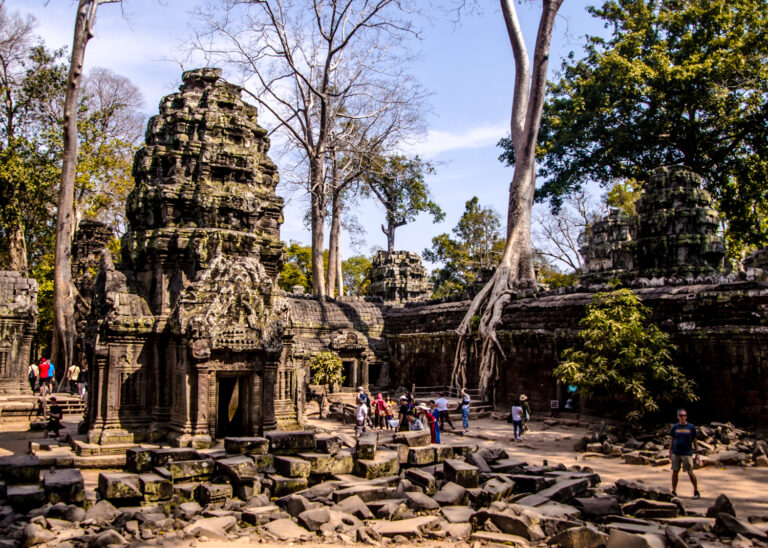
Banteay Kdai
Meaning “Citadel of Chambers”, Banteay Kdai is one of the only completely unrestored temples in the ancient city, although now it is being aided.
It’s pretty similar to Ta Prohm only much smaller, with enormous banyan trees still covering many walls and ruins in incredible fashion.
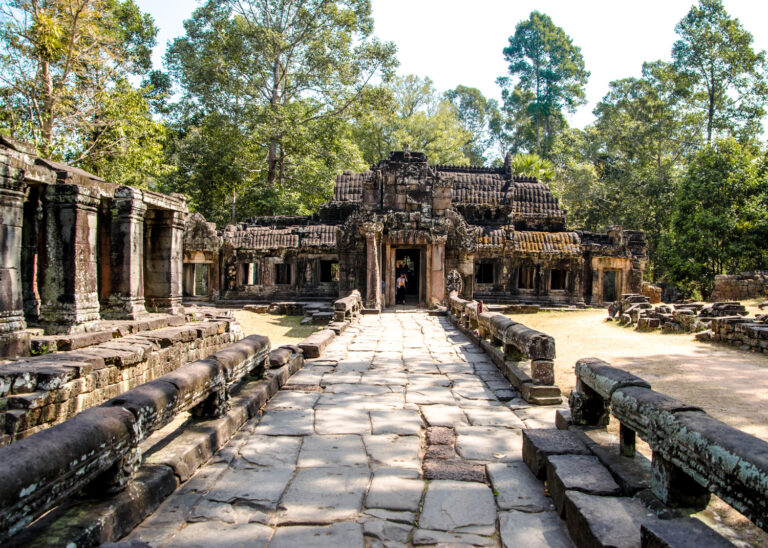
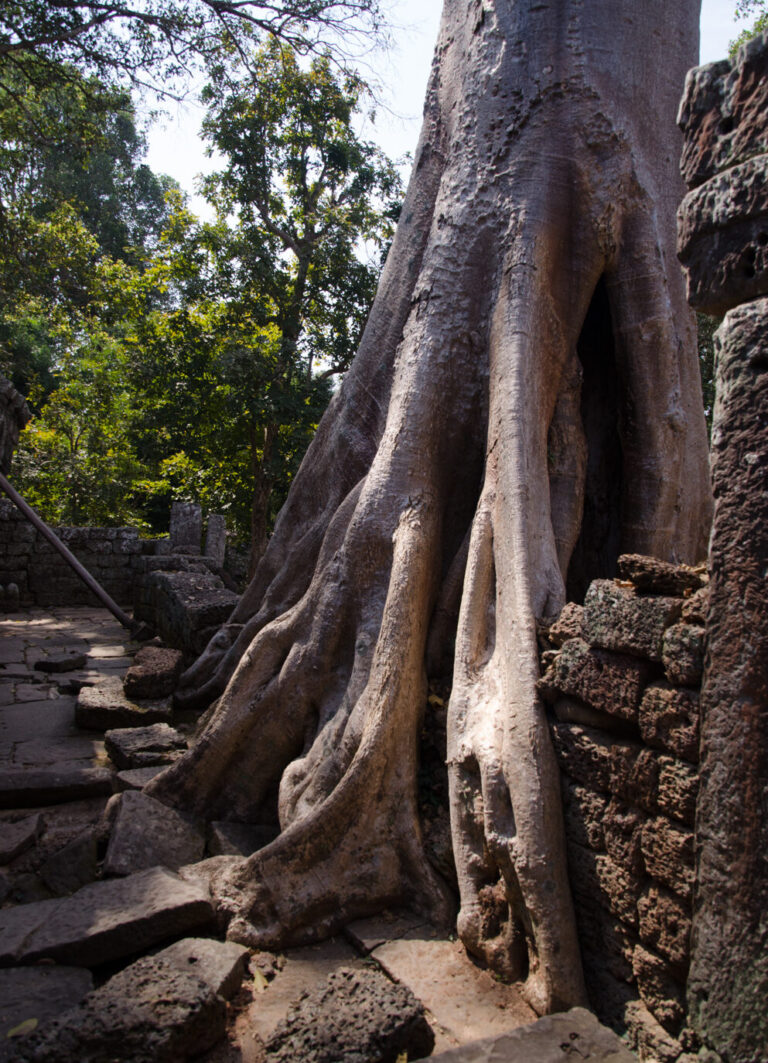
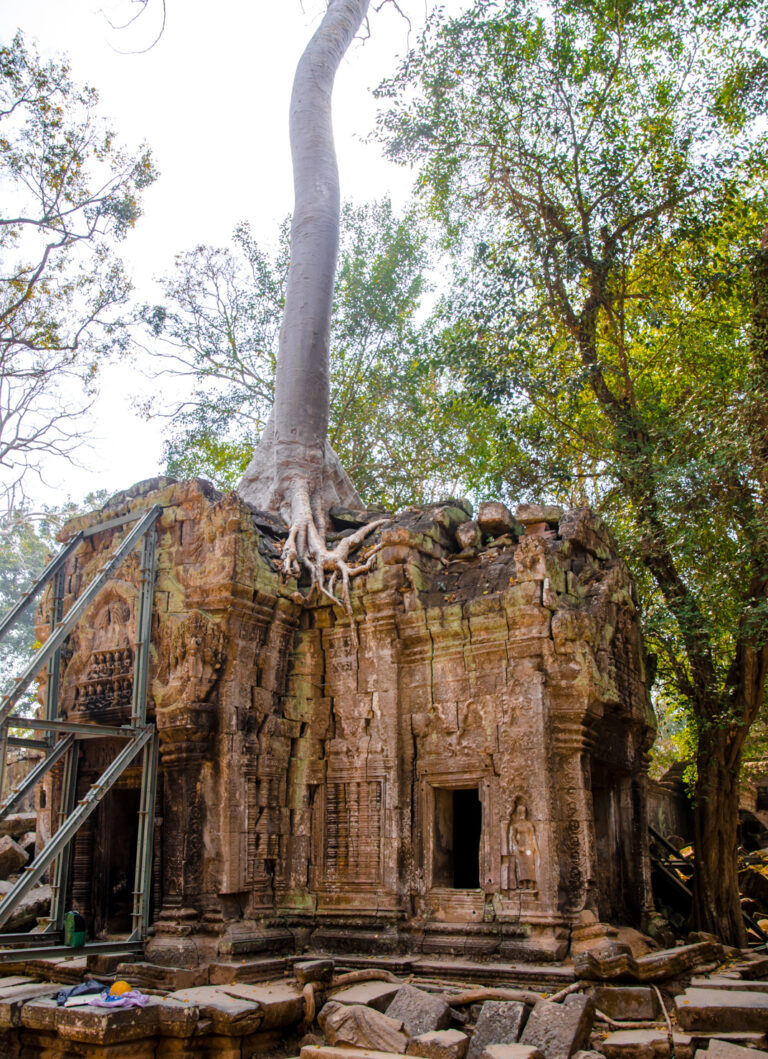
It really is no wonder why these temples are so famous around the world. The impressiveness of every single location in Angkor Wat is a sight to behold and the beauty of each one speaks for itself.
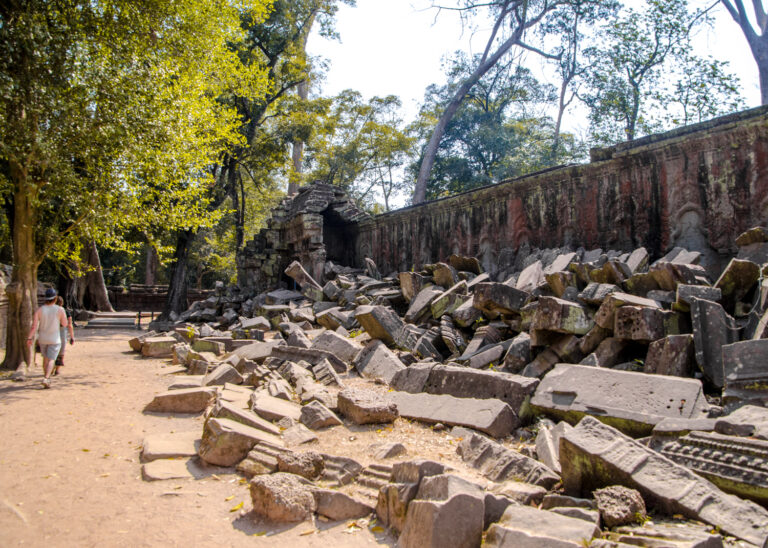
Srah Srang
Anybody else fancy a 700m long swimming pool? They certainly did everything on a large scale back then!
East of Banteay Kdai lies Srah Srang, “The Royal Bathing Pool”, which is a whopping 700 metres long and 300 metres wide. This 10th century outdoor pool is more like a lake than a swimming pool, but who am I to judge the Khmer kings.
It pre-dates any of the temples here and is the perfect way to round up your journey in Angkor Wat!
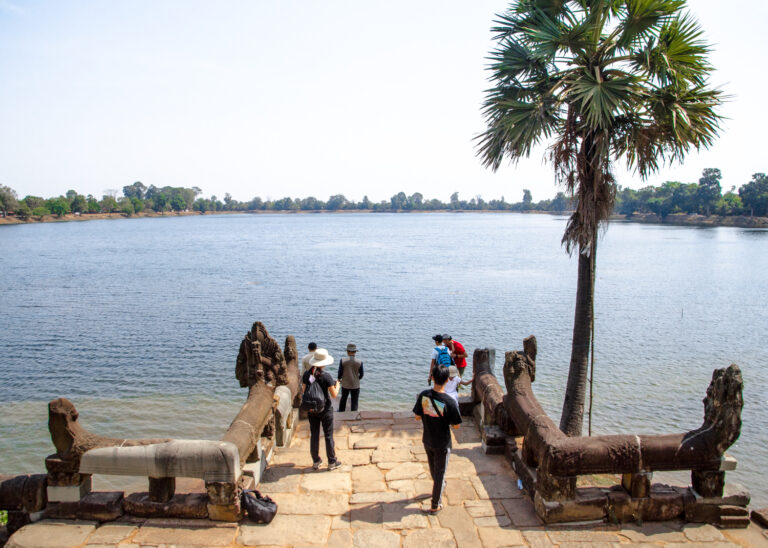
Where to stay in Siem Reap
There’s really only one option when it comes to looking for places to stay near Angkor Wat, and that’s the nearby city of Siem Reap.
Siem Reap has an array of accommodation options as well as affordable food and interesting sights. I stayed at Panda Angkor Inn which was great and they helped me book my Angkor Wat tour too.
Find somewhere you like on Hostelworld below.
Packing essentials for Angkor Wat
- Travel camera
You’ll want to remember your time at Angkor Wat, and what better way than having a compact travel camera to take nicer photos than a phone. I use this one which, for me, is an essential item anywhere. - Water
Make sure you pack a reusable water bottle and plenty of water as it will be a sweaty one at any time of year! - Portable charger
This will be a long day out and you’ll be taking lots of pictures. Therefore, best pack a portable charger so you can charge your devices on the move. - Hat, sunscreen and sunglasses
You’ll be exposed to the sun for most of the day, so make sure you protect yourself!
Thinking of visiting Southeast Asia soon? Don’t miss these essential guides to help planning your trip:
Best tours of Angkor Wat

Thank you for reading this travel guide – I hope you found it helpful! Feel free to leave a comment below if you have any questions and I’ll get back to you as soon as possible
Happy travelling!
HELPFUL RESOURCES FOR PLANNING YOUR TRIP
Accommodation: Booking.com, Hostelworld
Tours: GetYourGuide, Viator, Klook, TripAdvisor
Transport: 12Go, Omio, Trip.com, Rome2Rio
WHO IN THE WORLD IS JAMES?
Click below to learn more about my story, including 5 random facts about me, some travel FAQ’s and my entire travel history.

